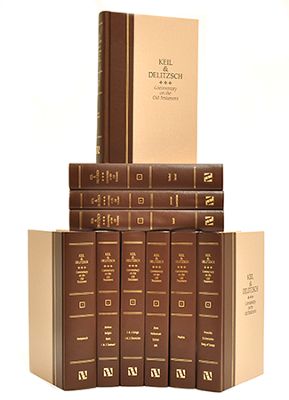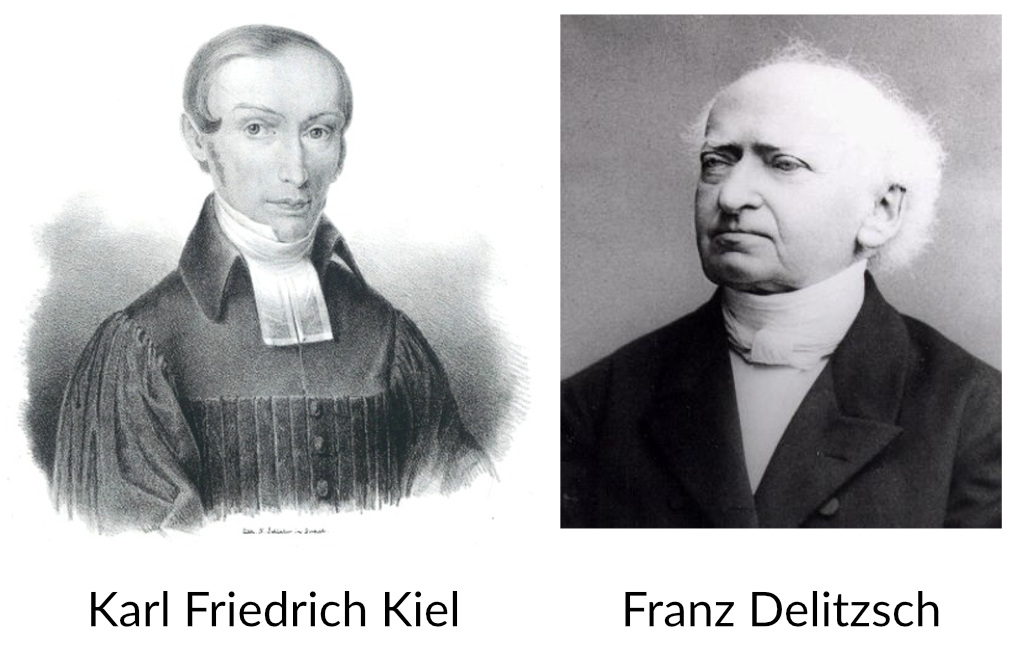
I confess that Keil and Delitzsch are a part of what I call my Apocalypse books. A few years ago, realizing that I rarely referenced physical copies of books that I also had in Accordance, I sold or gave away many of the physical duplicates. However, I saved a few titles and series for what I jokingly referred to as “apocalyptic purposes”—that is, physical books I could have access to at any point regardless of my ability to use electronic devices. These days, I’m actually pretty well set up to keep my devices charged up indefinitely via solar power in the event of any actual emergency situation, but I plan to keep Keil & Delitzsch (print and Accordance versions) regardless.
Commentary on the Old Testament (from here on referred to simply as K&D) by Carl Friedrich Keil (1807-1888) and Franz Delitzsch (1813-1890) began publication in 1861 in German and 1863 in English. The translation into English was completed in 1891. Since then, the ten volume commentary on the Old Testament has never been out of print. Moreover, because the original series is now in the public domain, it is easily accessible on innumerable websites and virtually every Bible software platform. Incidentally, the Accordance version of K&D is not the same as the free, public domain versions, which I will explain further below.
Both Keil and Delitzsch were German Lutherans. Living in an era that saw the rise of German theological liberalism, both men were well-versed in the scholarship of the day but chose to write their commentary from the convictions of a more conservative viewpoint, which may partly attest to the series’ continued popularity today. The two scholars split the work of the commentary between them with Keil writing on Genesis through Esther and Jeremiah to Malachi, while Delitzsch wrote on Job to Isaiah.
The commentary series was written at a time when a serious, educated reader of the Bible would be familiar with Hebrew, Greek, and Latin. Although K&D can be found through so many digital venues, I sometimes wonder how many people are actually using it on the popular sites when it pulls no punches in regard to its assumed knowledge of biblical and classical languages. In addition to the already-mentioned languages, readers will regularly come across references to content in Aramaic, Arabic, German (Keil especially likes to quote Luther in his native tongue) and other languages. The breadth of the authors’ knowledge is impressive for a day before being able to search for information on the internet or in Accordance. I often wonder what kind of files or record keeping they maintained to keep track of not just their thorough knowledge of biblical material (found in the Hebrew Bible, Greek Septuagint, and Greek New Testament), but also rabbinical literature, Patristic writings, and so many works of classical Greek and Latin origin.

In spite of some mild revisions, paragraphs often tend to be fairly long. They require the modern reader to focus to follow an argument or train of thought from beginning to end. However, I often consult these volumes simply to see what kind of insights on the biblical text I will find. I will offer here two examples.
First, here is Friedrich Keil’s comment on God’s covenant with Abraham and what it meant for his faith to be “reckoned to him as righteousness”:
The significance of the divine act is, finally, summed up in v. 18, in the words, “On that day Jehovah made a covenant with Abram.” Consequently Jehovah reckoned Abram’s faith to him as righteousness, by making a covenant with him, by taking Abram into covenant fellowship with Himself. הֶאֱמִין, from אָמַן to continue and the preserve, to be firm and to confirm, in Hiphil to trust, believe (πιστεύειν), expresses “that state of mind which is sure of its object, and relies firmly upon it;” and as denoting conduct towards God, as “a firm, inward, personal, self-surrendering reliance upon a personal being, especially upon the source of all being,” it is construed sometimes with לְ (e.g., Deut. 9:23), but more frequently with בְּ (Num. 14:11; 20:12; Deut. 1:32), “to believe the Lord,” and “to believe on the Lord,” to trust in Him,—πιστεύειν ἐπὶ τὸν Θεόν, as the apostle has more correctly rendered the ἐπίστευσεν τῷ Θεῷ of the LXX (vid., Rom. 4:5). Faith therefore is not merely assensus, but fiducia also, unconditional trust in the Lord and His word, even where the natural course of events furnishes no ground for hope or expectation. This faith Abram manifested, as the apostle has shown in Rom. 4; and this faith God reckoned to him as righteousness by the actual conclusion of a covenant with him. צְדָקָה, righteousness, as a human characteristic, is correspondence to the will of God both in character and conduct, or a state answering to the divine purpose of a man’s being. This was the state in which man was first created in the image of God; but it was lost by sin, through which he placed himself in opposition to the will of God and to his own divinely appointed destiny, and could only be restored by God. When the human race had universally corrupted its way, Noah alone was found righteous before God (Gen. 7:1), because he was blameless and walked with God (Gen. 6:9). This righteousness Abram acquired through his unconditional trust in the Lord, his undoubting faith in His promise, and his ready obedience to His word. This state of mind, which is expressed in the words הֶאֱמִין בַּיהָוֹה, was reckoned to him as righteousness, so that God treated him as a righteous man, and formed such a relationship with him, that he was placed in living fellowship with God. The foundation of this relationship was laid in the manner described in vv. 7-11.
To get a taste of Franz Delitzsch’s writing, note his comments on Psalm 23:4-5:
Rod and staff are here not so much those of the pilgrim, which would be a confusing transition to a different figure, but those of Jahve, the Shepherd (שֵׁבֶט, as in Mic. 7:14, and in connection with it, cf. Num. 21:18, מִשְׁעֶנֶת as the filling up of the picture), as the means of guidance and defence. The one rod, which the shepherd holds up to guide the flock, and upon which he leans and anxiously watches over the flock, has assumed a double form in the conception of the idea. This rod and staff in the hand of God comfort him, i.e., preserve to him the feeling of security, and therefore a cheerful spirit. Even when he passes through a valley dark and gloomy as the shadow of death, where surprises and calamities of every kind threaten him, he hears no misfortune. The LXX narrows the figure, rendering בגיא according to the Aramaic בְּגוֹא, Dan. 3:25, ἐν μέσῳ. The noun צלמות, which occurs in this passage for the first time in the Old Testament literature, is originally not a compound word; but being formed from a verb צלם, Arab. ḍlm (root צל, Arab. ḍl ), to overshadow, darken, after the form עַבְדוּת, but pronounced צַלְמָוֶת (cf. חֲצַרְמָוֶת, Ḥaḍra-môt = the court of death, בְּצַלְאֵל in-God’s-shadow), it signifies the shadow of death as an epithet of the most fearful darkness, as of Hades, Job 10:21f., but also of a shaft of a mine, Job 28:3, and more especially of darkness such as makes itself felt in a wild, uninhabited desert, Jer. 2:6.
Both of these examples show depth of thought and familiarity with language and biblical material. In my personal use, realistically, K&D may not be my first stop in looking at a passage, but I nevertheless do stop in regularly and linger a while on their (print or digital) pages.
Having extolled the strengths of this series, it would be inconsiderate not to mention a few weaknesses. Remember that these are 19th century works. That, by itself, is not bad; but the reader should keep in mind that the series is limited to the knowledge and scholarship of its day. There have been tremendous developments in archaeology that have delivered invaluable insights onto biblical material since K&D was written. The same holds true for better understandings of biblical languages, especially Hebrew, in spite of the vast knowledge the two authors had for their time. These volumes were also written before the discovery of the Dead Sea Scrolls, which had tremendous impact upon understanding the development of Old Testament material.
Earlier, I mentioned that the version of K&D found in Accordance is not the same as what can be found for free download or on Bible study websites. Our edition is the mild revision from Hendrickson completed a few years back. Errors found in the original series were corrected, Arabic was transliterated, and biblical references were changed from Roman to Arabic numerals. And, of course, the Accordance editions contain tens of thousands of hyperlinks to biblical verses and other material.
If you’re interested in learning more about the history of Carl Friedrich and Franz Delitzsch, I highly recommend the article by J. W. Rogerson in IVP’s Dictionary of Major Biblical Interpreters, also available for Accordance. And for a limited time, you can add this time-tested commentary to your personal Accordance Library for an incredible 80% off the regular price.
Commentary on the Old Testament (Keil & Delitzsch) (10 Volumes)
Reg Price $99.90; Sale Price $19.90 | Buy Now
Above sale price good through Monday, July 12, 2021 (11:59 PM EDT)

